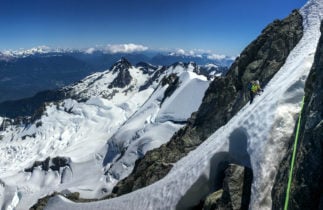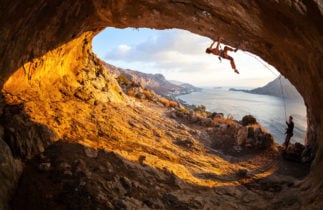Rock Climbing in Arizona: In Search of New Frontiers
Table of Contents
Dropping down through Oak Creek Canyon, a river gorge with hairpin turns, I thought to myself, I guess I don’t know Arizona. All around, 800 foot sandstone cliffs and pillar formations cast up as we drove—a golden sea splashing with buffed gray, giving way to ferric reds bounding thick strips of limestone.
I couldn’t believe I hadn’t been down here before. But descending was only half the fun that day.
Later, topping out on a tiny spindle big enough for just a couple, looking at the air underneath and all around, it felt like we were at the edge of a map peering—at a new frontier of climbing, and, just maybe, one of the best places for rock climbing in the world.

A Primer for Rock Climbing in Arizona
Climbers have long since flocked to the Southwest for sunshine and splitters year-round, often overlooking Arizona for other nearby destinations like Moab, Joshua Tree, or Las Vegas. Moving here from Colorado, I thought it would be a step back in terms of climbing options too. Instead, I found an expanse of untapped potential—and that’s not counting the 9,000-plus named routes that already exist!
What a lot of people don’t realize is that the state is home to more than desert. Well let’s be clear, there is a lot of that—including the four distinct regions of the Chihuahuan, Mojave, Sonoran, and the Great Basin—but you also get tall mountain ranges (which are snowy enough for backcountry skiing), subalpine forests, deep canyons (hiking in Grand Canyon is the best in the state), and mesas.
Throughout Arizona’s geologic diversity is a wealth of climbable rock: granite, quartzite, basalt, limestone, sandstone, gneiss, welded tuff, and many other types. In the north, you have higher elevation crags around Flagstaff, Sedona, Prescott, Queen Creek Canyon, and McDowell Mountain, while in the southern end surrounding Tucson is one of the largest undiscovered frontiers of climbing in the U.S. Even the places people know about, such as Mt. Lemmon and Cochise Stronghold, have a lot of room for expansion and development.

Of what is known, there’s a little something for everyone—from clipping bolts and climbing hard on some of the steepest granite crags in the Southwest to gritty adventures pulling off hunks of rock and cleaning dirt out of your ears for days after.
As you can imagine, word is starting to spread and interest in Arizona climbing is growing. At least for now, you can still get out on one of our many bluebird days and have no trouble jumping on the route you want. I like that feeling, of being in an area where there’s a lot of untapped things to explore, it only took me moving to a city to realize it.
The Music Reverberates in the Desert
In another life in another universe I am a studio musician.
It’s not far-fetched; I went to a big city to get perspective and a music degree. Halfway through school though, I realized, I’m probably going to pursue something that will keep me away from the mountains. So I cut loose.
These days I still play, but whenever I try to make money off music it starts to blow a hole in all of it. Now, I find and make music among the desert and natural amphitheaters—the warble of my Navajo flute soars like a cactus wren surfacing in the sky.
The open desert environments, while as beautiful as the ones you’ll find on the best Grand Canyon hikes, are also excellent for climbing. It’s that potential that drew me to starting a guiding company, Arizona Climbing Guides, in the state that until recently has been somewhat of a “wild west” of development. While climbing in Arizona has remained less well-known, I’m hoping this guide can be a jumping off point for those wanting to adventure here.
1. Cochise Stronghold
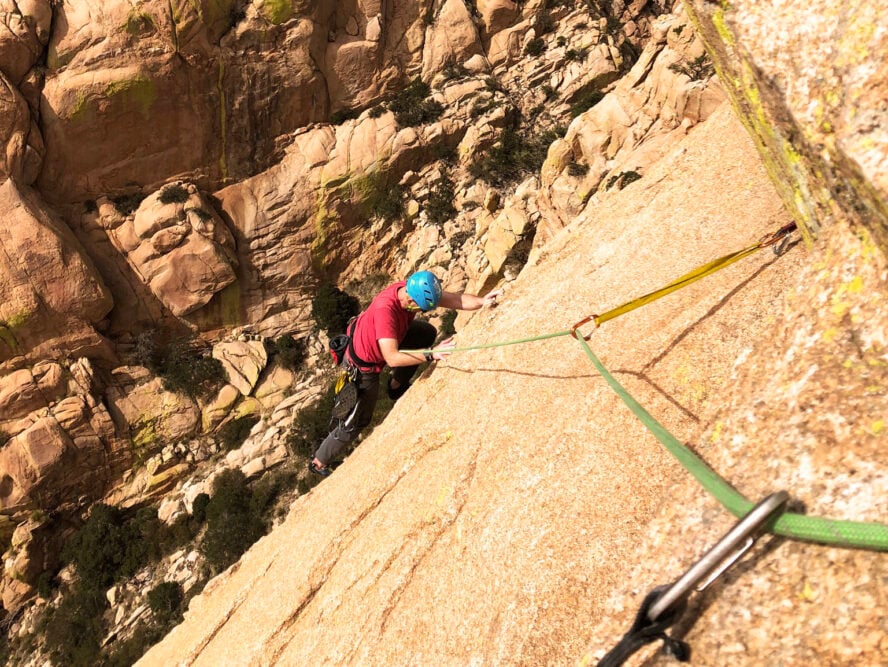
A Serengeti of the southwest
Entering Cochise, I feel like I’m in the Serengeti. As a transition zone between the climate of the Sonoran desert and higher elevations, there’s scrubby trees and tall native grass that resembles the grasslands of Africa.
Named after the Chiricahua Apache Chief, Cochise, this rock fortress was his and his followers’s home for some 15 years in the mid-1800s as they evaded and fought against the U.S. army. In modern day, Cochise is a beautiful wilderness setting where you can spend a day climbing even the most classic routes without seeing a single other person.
Climbing at Cochise Stronghold is all about having a remote desert experience and getting high off the ground on one of its many multi-pitch options. You can keep it low-commitment by cragging, maybe getting on some slab, or go for a bit of an adventure on a run-out granite face climb up one of the domes. There are also a lot of cool routes perfect for an introduction to moderate multi-pitch climbing on impeccable rock with incredible views.
Overall, the vibe here is old-school adventure climbing, with longer approaches and a plethora of high-quality crack climbs. The majority of the routes are trad, with 600-plus routes on the yellow and pastel green formations that reach up to 800 feet. There’s also plenty of bouldering and sport for those who want it. With Arizona’s temperate climate, Cochise Stronghold is climbable year-round, though conditions are most comfortable in spring and fall.
Take a tourist rest day at Tombstone
Tombstone is one of the many southeastern Arizona towns shaped by the unpredictable economy of mining, and formerly by gold. In a wilder era, the town was known for its residents, both outlaws and lawmen such as the Cochise County Cowboys and Virgil Earp.
Today, while a bit cheesy, it’s a fun place to grab a bite to eat, drink a beer, and watch people walk around in period clothing after a long-day of climbing at Cochise Stronghold. You can also catch the daily high noon gun battle.
Recommended climbs at Cochise Stronghold
What’s My Line — 5.7
Three-pitches which starts with a required pendulum before bringing you out of a gully with 250’ feet of open air below you. This route is great because while the climbing is easy, the exposure is on par with something three grades harder due to the start.
Ewephoria — 5.8
Another good, slightly longer climb comprised of 5-pitches of crack and face climbing. After the first pitch, it is mostly bolted, though you can place gear if you want to run it out less. Finish going over an overhang and end a sharp arete.
You get these huge plates that look like scales and can turn into something of a sky ladder. It's almost like it's made to be climbed.
Jayci Ferrimani



1. Cochise Stronghold - Good to Know
Beginner to advanced
Mostly traditional crack climbing
For east, take exit 318 off I-10 through the town of Dragoon and then a right onto Cochise Stronghold Road. For west, take highway 80 from Benson and then after 20 miles a left onto Middlemarch Road
Day use fees are $8
Dispersed camping offered in both East Stronghold and West. There is an established Forest Service Campground on the east side with toilets but no water
Year-round climbing but best conditions in Spring or Fall
La Cocina/TallBoys (now merged) in the Historic Presidio District of Tucson is my choice for outdoor dining and live music. For authentic Mexican, try El Charro Café
Summit Hut is a local chain first opened in 1967. With two locations (one in Tucson, another in Oro Valley) they have all the goods you may have forgotten at home
“Cochise Stronghold: The Complete Set (2017)” by Tanya Bok
2. Mount Lemmon
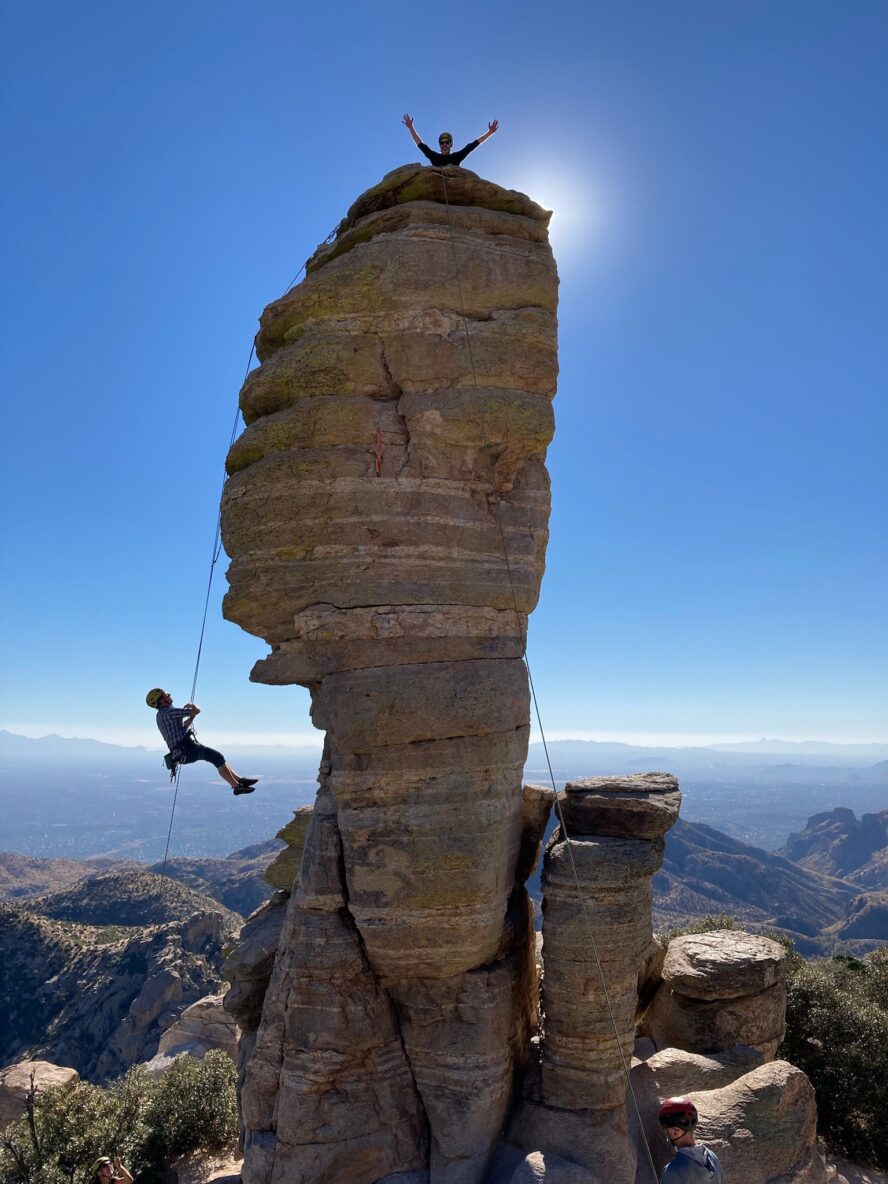
Choose your adventure: Altitude and style for everyone
Just outside Tuscon in the Santa Catalina Mountains, Mt. Lemmon is one of the most popular climbing spots in Arizona. It boasts thousands of climbs—from bouldering at Mystic and Linda Vista to 10-pitch sport climbs—and because the average highs are in the 70s in February, it makes a terrific winter destination. The majority of routes are accessible via the Catalina Highway (recently designated as the Sky Island Parkway) so you can have a full day of climbing and easily return to town for dinner.
On Mt. Lemmon, you can decide what elevation and rock type they want to climb. Ranging from gneiss and year-round warmer temps at 2,000 feet to alpine granite at the summit, nearly 10,000 feet above sea level, the mountain provides plenty of options depending on your interest and weather that day. In fact, driving through the pass will bring you up and down more than 5,300 feet and through five of North America’s distinct ecological zones.
Something for everyone
Historically, Mt. Lemmon was home to old-school trad. While those are still available, modern development has expanded the style primarily towards sport climbing and routes suitable for beginners.
This wide variety is part of what makes Mt. Lemmon special; at Windy Point, for example, a group including someone climbing for the first time and a 5.14 crusher could head up and spend the day cragging within walking distance of each other.
It's really hard to think of anything negative to say about Mount Lemmon: you have a good combination of ease of access and a variety of different climbing—from multi-pitch trad to 1,000s of sport routes.
Jayci Ferrimani



2. Mount Lemmon - Good to Know
Beginner to advanced
Multi-pitch trad, sport, bouldering
No fees for most trailheads with the exception of the $10 per day for the summit. Note that some areas have seasonal closures from January-July for the protection of peregrine falcons and bighorn sheep
There’s a plethora of developed camping alongside the roadway such as Molino Basin. For a little more luxury, one could stay at the Ventana Canyon Lodge or even Dove Mountain Ritz Carleton
Year-round, especially below mid-mountain
Hit up LaCo (La Cocina, aka Love and Community) for a rustic cantina and live music under the stars
Summit Hut is a local chain first opened in 1967. With two locations (one in Tucson, another in Oro Valley) they have all the goods you may have forgotten at home
“Squeezing the Lemmon III Enough Lemmonade for a Lifetime: A Rock Climber’s Guide to the Mt. Lemmon Highway Arizona (2015)” by Eric Fazio-Rhicard
3. McDowell Mountains

Granite climbing at it’s finest (and hottest)
Located a little less than an hour via car from Phoenix and only twenty minutes from Scottsdale, the McDowell mountains offer a great introduction to Arizona granite climbing while remaining close to urban areas. The best seasons to climb are winter, spring, and fall as the Phoenix metro area has some of the highest average temperatures in the U.S. (including an average high of 104.5° F in July), which makes the 20,000-plus acre McDowell-Sonoran preserve a recreational reprieve.
The climbing in the McDowell Mountains is largely single-pitch trad from 5.3 to 5.12, but you can also find some bolted routes and bouldering here. The Gardiner’s Wall offers a few multi-pitches excellent for beginners to practice their skills. In fact, the Gardiner’s Wall is one of the few spots available for multi-pitching northeast of Phoenix. A few easy-to-moderate multi-pitch classics include the two-pitch 5.5 Hanging Gardens and 5.7 Renaissance Direct.
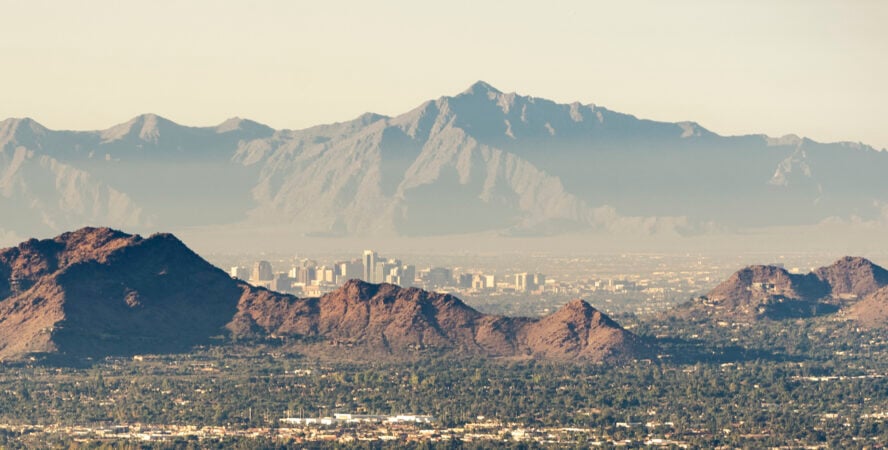


3. McDowell Mountains - Good to Know
Beginner to advanced
Crack and slab on rough grained granite are the name of the game
Start at Tom’s Thumb Trailhead. To get there, head east on Happy Valley Road until it turns into 118th north bound. Make a right on Ranch Gate Road (look for signs to the trailhead) and go east to 128th Street. Make another right and go south until you reach Tom’s Thumb Trailhead
Free but must be accessed via established trails and trailheads
Scottsdale offers many Airbnbs options. The Bespoke Inn Cafe and Bicycles bed and breakfast is good for those willing to splurge
Winter and spring (gets toasty in the summer; Phoenix has some of the highest temperatures in America)
Blue Clover Distillery in Old Town Scottsdale is a good spot to grab a drink, and their menu includes a create-your-own pizza and salad option
Just Roughin’ It. Guiding service turned gear shop, this is an excellent local option for picking up any gear you need
“McDowell Rock — A Climber’s Guide” by Erik Filsinger and Cheryl Beaver
Central Arizona is home to Africanized honeybees, sometimes referred to “killer bees.” As long as you don’t swat, you will generally be safe
4. Queen Creek Canyon
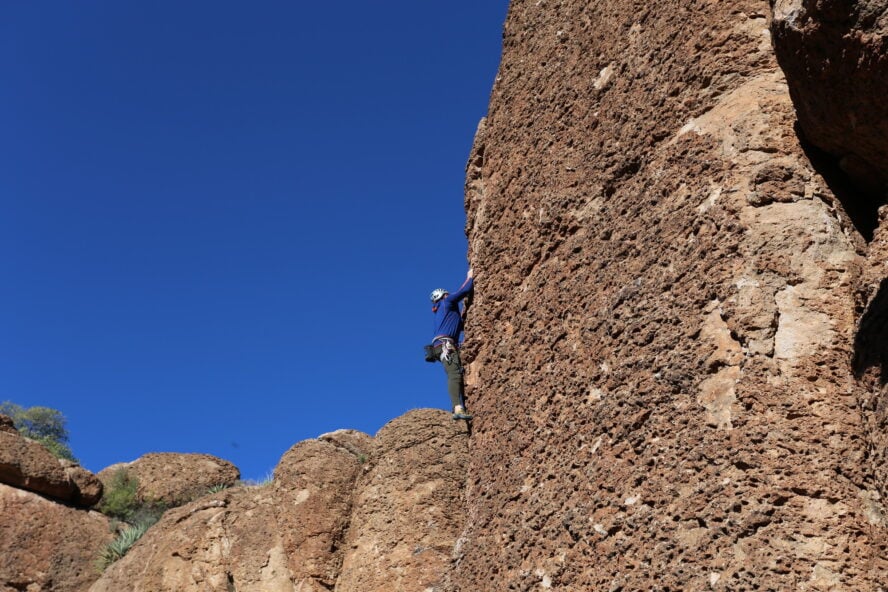
Get ready to try hard
The Queen Creek climbing area is conveniently located 45 minutes southeast of Phoenix. Filled with towering spires and endless fields of boulders, there are about 1,000 routes and nearly 2,000 problems across a wide range of difficulties. In fact, the Phoenix Bouldering Contests were hosted in Queen Creek for 15 years from 1989 to 2004.
Unlike the rest of Arizona rock climbing, Queen Creek Canyon is full of volcanic towers which makes for a unique style of pocketed volcanic tuff and tiny-crimps (similar to the type of climbing you’ll find at Smith Rock). It’s the perfect place for those wanting to crank hard on friction face climbs.
Unfortunately, Queen Creek Canyon is the site of several land use battles. The Resolution Copper Mine owns most of the land so access is a bit precarious. Since the Queen Creek Coalition signed a Recreational Use License with the mine, climbers are able to use the area after registering and filling out a liability waiver.
Take a dip at The Pond
As one of the most popular destinations in the Queen Creek Canyon, The Pond showcases sunny, south facing walls with lots and lots of deep pockets and plenty of moderates. It is part of “The Road Area” making it easily accessible. There are almost 300 mostly sport routes and nearly 100 boulder problems.
The Queen Creek area has a lifetime of routes and boulders to be climbed.
Jayci Ferrimani



4. Queen Creek Canyon - Good to Know
Beginner to advanced
Pockets and crimps on featured faces and slabs
Located four miles outside of Superior, AZ, take Highway 60 east from Phoenix for about an hour and through the Queen Creek Tunnel
Registration needed to climb at Pond and Atlantis areas
The Oak Flat Campground offers free camping (Forest Service land)
Year-round, although summer can get hot
Joyride Taco House is a good bet for a post-climb meal, and for sweets I recommend Karl’s Quality Bakery
Arizona Hiking Shack has been locally owned since 1972, started as a literal 10′ x 20′ miner’s line shack. Today, it has plenty of gear for backpackers and climbers
“The Rock Jock’s Guide to Queen Creek Canyon Superior, Arizona” by Marty Karabin
5. Granite Dells and Granite Basin

Easy access by staying central
If you want to add a little more to your Arizona experience beside the Grand Canyon tour, the Granite Dells and Basin are excellent options. The Dells are actually within the city limits of Prescott, making it one of the most accessible locations—it’s just about a ten minute drive with another 10-20 minute approach.
Traditionally, this has been a local’s area but has seen a lot of development over the past ten years or so. The rock is a small, grainy composite—much like that found in the Sierras—setting the Dells apart from the climbing in the rest of Central Arizona. Much of the climbing is on large standalone boulders and rounded cliffs, with many right on the shore of Watson Lake if you want to take a dip to cool off (or paddleboard or kayak for that matter). When the Dells get too hot in the summer, further to the west in the Prescott National Forest is the Granite Basin which features cooler temperatures year-round and a more remote experience.
Climbing at Granite Dells and Basin started in the 1970s with trad and bouldering, but with recent development has become beginner and intermediate friendly. The routes tend towards the shorter end, though there are more than enough—600-plus, primarily in the 5.6-5.12 range—to get mileage in.
Where to climb at Granite Dells
Some of the first places developed in the Granite Dells were the Granite Gardens and the High Rappel Area. The High Rappel Dell features more tough, old-school trad routes but it holds value for beginners as well, especially those that want to practice rappelling on the huge eyelet bolts.
Across Granite Creek is The Oasis area of the Granite Gardens. One of the newer areas is Shady Grove, which as the name suggests, is south-facing and shaded by trees.
Recommended climbs for beginners
Panda Cub — 5.5
Sport route at the Panda Wall which follows a left-facing corner to bolted anchors.
Hop, Skip, and a Jump — 5.7(ish)
This trad route at the Grotto, a small canyon along the Grotto Trail, follows an arete and requires a particular move, as the name suggests.
Magister Ludi — 5.7+ (PG13)
This is the go-to route in the area. At the Waning Wall, a cliff that runs about 100’ tall, the climb follows a crack up into a shallow left-facing corner before continuing into a better crack to the top.
Déjà Vu — 5.8+
In Shade Grove, this sport route climbs on classic Dells slab and somewhat tricky feet.



5. Granite Dells and Granite Basin - Good to Know
Beginner to moderate
Traditional (grades can be a bit stiff), sport and bouldering
Only a 10 minute drive outside Prescott and 45 minutes from Sedona
$2 admission fee
Camping for $10-15 dollars at the Granite Dells or base of Granite Mountain, or look for camping in the National Forest land around Prescott. If you want to stay in Prescott, there are plenty of affordable hotels
All seasons. It can get warm in the summer but there are plenty of shady spots
“The Granite Dells Climbing Guide” by Kevin Keith
Acknowledging the past and present
Much of the climbing in Arizona rests on the historically Indigenous lands of tribes such as the Apache, Cherokowa Apache, Puebloan groups, Zuni, and others, and remains near present day reservations. This legacy is a very present part of the culture and it’s important to both acknowledge and educate oneself about when visiting the area.
When at Cochise, I talk about what the Cherokowa-Apache went through, such as getting shipped off to reservations. I talk about Geronimo and I try to point out to people the pictographs on overhanging rocks. I also share that the indigenous peoples are still here in the area, still valuing the land, and consider it part of their people.
A Frontier for Everyone to Access
While Arizona is already known for its hikes and mountain biking, rock climbing is growing as another way to enjoy this vast landscape of red rock and towering spires. For me, the joy of living here has been about the exploration—like crafting a new song, you’re never quite sure what you’ll come up with. In the end, I’m glad I made my way here, and I hope to keep welcoming folks to this slice of the Southwest.



